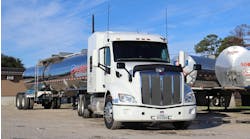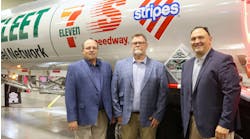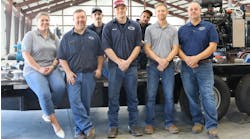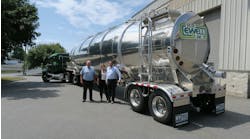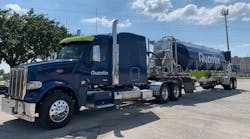The only thing better than a brand-new trailer is a better-than-new trailer.
That’s the inspiration behind A&R Logistics’ new trailer improvement project, which is intended to bolster the appearance, functionality, and safety of the company’s signature vacuum pneumatic dry bulk trailers, and, in turn, help increase driver retention amid the country’s ongoing driver shortage.
A&R allocated $1 million for the initiative this year, with the goal of overhauling 55 of its 1,400 pneumatic trailers, and already budgeted another $1 million to continue the project—which is being paired with an influx of new tractors—through at least 2022.
“Our goal wasn’t to make these trailers new,” said Rob Oppenlander, vice president of dry bulk fleet maintenance.
“Our goal was to make them better than new, so they run more efficiently.”
Initiative’s inception
A&R is the largest plastic carrier in the nation, primarily hauling resin pellets of polyethylene, polyethylene terephthalate (PET), and polypropylene, materials used in a wide variety of packaging for everything from water and soda, to pharmaceuticals, oils and gasoline. Plastic resins also go into carpets, vehicle bumpers, wallpapers, credit cards, and myriad other everyday items—ensuring A&R is always busy.
Related article: A&R Logistics rebrands as Quantix
As a result, the daily, real-world focus typically is on keeping the tank’s interior clean, and routine preventive maintenance items, such as the grease jobs, brake inspections and light checks all trailers require at regular intervals. And while those tasks keep equipment running down the road, they don’t necessarily make the driver’s job easier or safer, or impress customers or the public when they see A&R’s trailers.
That’s why the carrier is going beyond the DOT inspection checklist for a deeper dive into trailer functionality.
“We’ve noticed over the years that the mechanics of our trailers, which our drivers depend on, was wearing down, making it harder to load properly,” said Steve Brantley, A&R’s senior vice president and chief operating officer.
“Appearance is huge for A&R and always has been. Now the operation of the trailer is critically important. In today’s environment, with the driver shortage, we need to remove frustrations. So we feel this project will pay dividends. We expect it to pull our turnover down, and bring our retention up, by giving our drivers trailers that do their job, without the driver having to work extra hard to make them function.”
The process starts with selecting trailers most in need of a new life. “We take trailers that are older, don’t look as good, and need a lot of components changed out, and those are the trailers that are pulled out of service and go through this program,” said Jim Daebelliehn, vice president of transport operations.
Once identified, trailers are routed to one of two terminals that perform the work, in Highlands, Texas, and Morris, Ill., where maintenance director Ed Oppenlander oversees progress. Each facility can refresh four to five trailers per month, Brantley said. When the trailers—primarily aluminum J&L dry bulkers—arrive, personnel pinpoint parts for replacement, strip down each unit so everything’s accessible, and put them through Fleetclean Systems’ two-step wash process.
Then, under the watchful eye of Richard Munoz, A&R’s director of tank wash operations based in Highlands—who’s charged with coordinating efforts between the two facilities, and ensuring trailers come out of each looking identical—the units are rebuilt with premium components, many upgrades, and brilliant new logos, and returned to service.
“Even though you might have a 1997 trailer, if it goes through this program in 2021, for all intents and purposes, it’s a 2021 trailer,” Daebelliehn said.
Equipment upgrades
Components replaced include valves, fittings, dome lids and latches, gaskets, wiring harnesses, and anything else drivers depend on to perform their daily duties, maximize payloads, increase efficiency—and delete dissatisfaction.
And that’s just for starters.
“What Steve challenged us to do was not only to make that trailer as if it were new, but to make it better than new,” Oppenlander said. “So we’ve done some creative things, like relocating temperature gauges, making them more accurate for our drivers, when they are reading the gauges, and more visible, by positioning them at eye level.”
A&R also is moving to LED lighting by Truck-Lite, and adding flood lights that improve safety in low-light settings.
“We upgraded everything from the old incandescent lights, which burned out all the time, and switched them all over to LEDs, so we could accommodate our drivers better,” said Troy Basso, A&R’s vice president of maintenance. “They don’t have the problem of turn signals going out near as often with these.
“It makes their job easier, and the cost difference over the life of the unit is minimal.”
Tanks and equipment are inspected to verify they’re holding pressure, and loading or unloading as designed, and any cargo tank deficiencies are addressed. The large, rear-end filter canisters—the most recognizable apparatus on a vacuum pneumatic trailer—are disassembled and cleaned, and filters are replaced as needed.
Underneath the key product-handling equipment, A&R is adding new trailer frame rails, replacing suspensions, utilizing enclosed S-cam tubes for extended brake platform longevity, and equipping new Alcoa wheels and Yokohama tires.
Suspension systems are fully dressed, and not refurbished, HT230 air suspensions from Hendrickson. Their installation coincides with newly modified, more practical, dual axle spacing. “We have made some minor tweaks and adjustments to spec these trailers in a way that works better for A&R,” Oppenlander explained.
Finishing touches include premium, ultra-durable Imron coatings from Axalta, new stainless-steel hoses with all-white neoprene gaskets from Geib Industries, and pristine decals—which cost $1,200 per tank. “We spend quite a bit of money on those logos,” Brantley confided. “But trailer appearance is very important.”
Virgin rubber
Tire retreads are a popular choice today, but A&R isn’t on board, so all tires equipped during the project boast EPA SmartWay-approved “virgin rubber.”
“We don’t have luck with retreads,” Brantley said. “I don’t know anybody who really does. It sounds good on the front end, feels good on the bill, but at the end of the day we’ve realized they tear up more, and leave our drivers on the side of the road.”
According to Daebelliehn, retread reliability is of particular concern for bulk transporters, who haul heavier loads than their dry-van counterparts. “We’re grossing out our trailers, with our loads, so we’re putting a lot more stress on tires,” he said. “With a van driver, he may be empty half the time, or hauling 40,000 pounds, where we’re 49 or 52,000 pounds. So we’re running max legal gross every time we load a trailer.” And when a tire on a vacuum pneumatic trailer loses a recap, it tends to take out vital equipment.
In addition to brand-new tires, every trailer receives the Meritor Tire Inflation System (MTIS), which maintains proper tire pressure, improves fuel economy, and reduces the risk of blowouts and wheel-end damage, and WABCO’s four-wire, anti-lock braking system.
Oppenlander said they’re also testing different tread patterns. “One group of drivers up north will tell you all day they need a heavy, deep-lug tire,” he said. “But we all know you don’t need that running the Gulf Coast, so we’re trying to find the tire that gives us a happy balance in wear, miles per gallon, and driver satisfaction.”
Truck technology
A&R is pairing its overhauled trailers with new power units from Peterbilt.
The fleet now includes about 250 newer-model Peterbilt 567s, and the company plans to order 100 more next year, Brantley said. And, according to Basso, “Every single piece of technology you can put in that cab, we’ve put in.”
Traditional long-hood tractors, with big chrome stacks, look great, but they’re inefficient in a plastic-hauling operation, Basso said. The 567s give them a strong mix of the latest aerodynamics and emissions technologies, and most advanced safety systems, while still providing custom-truck appeal on the highway.
Trucks boast the Bendix Fusion Advanced Driver Assistance System, which integrates camera, radar and brake technology. Safety features include collision mitigation, stability control, and lane departure warning. The system utilizes factory-installed, forward-facing cameras—A&R does not use inward-facing cameras, which Basso says are unpopular and largely unnecessary, at least for now—and is tied to the SafetyDirect web portal, which transmits near real-time driver performance data to A&R’s safety department for review.
Further specs include WiFi hotspots, disc brakes all around, Endurant 12-speed automated transmissions, from Eaton Cummins, column-mounted gear shifters, fully customizable digital dash displays that light up with critical warnings, and a Gardner Denver blower system that runs cooler, and 50% quieter.
Combined, A&R’s most efficient semis now are achieving 6.8 miles per gallon—despite pulling pneumatic trailers that act like anchors. “We’ve increased our fuel mileage by almost a mile a gallon with the new 567s, and all their technology,” Basso maintained.
Positive return
A&R’s trailer initiative is intended to boost functionality, appearance, and driver retention, by eliminating those exasperating equipment issues that often are compounded while working in tight spaces, or extreme weather conditions.
Improved performance in roadside inspections is an added bonus that’s equally important to a carrier’s reputation.
“It also helps us with our CSA scores, because now we’re taking a 1997 trailer off the road, and, for all intents and purposes, putting a 2021 trailer back on the road, with LED lights—which last longer and are less prone to failure than incandescent—and new rubber on the tires,” Daebelliehn said.
Drivers respect an operation that values its equipment, Brantley added. They also like to work with equipment they know, so A&R assigns revitalized trailers to specific drivers where possible, which also helps A&R track how they’re treated. “That works two ways,” he said. “It lets the driver know exactly what they’ve got to work with each day, and it lets us know where to look to find out who tore up a fender or hose tube.”
Bottom line: A&R’s trailer project is a relatively minor expense for an operation with 2020 revenues of $324 million, but a major investment in the future of the company’s most invaluable assets—its drivers, and its equipment.
“We feel we’ll double the life of our equipment through this project, because when we’re done, these trailers basically are new,” Basso said. “They typically operate for 40-plus years anyway, if you treat them right, and with the steps we’re taking, we expect to extend their useful life well beyond that mark.”
